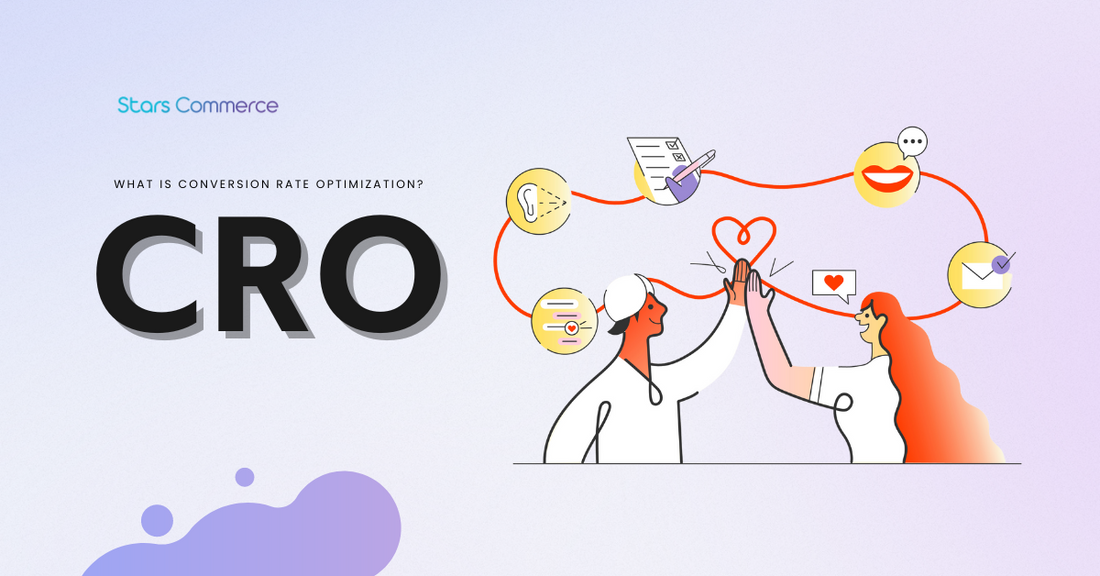Whether you own an ecommerce website, manage an online marketing team, or are responsible for your brand’s SEO efforts, you’ll know how vital conversions are to your business. Conversion rate optimization practices maximize your potential for drawing in customers.
What is Conversion Rate Optimization or CRO?
Conversion rate optimization is a data-driven approach of increasing the percentage of users who perform a desired action on a website.
To successfully improve your conversion rate, you must deeply understand your user behavior, engagement metrics, and conversion funnels. You need to understand how they navigate your website, interact with your content, and ultimately take action.
Desired actions, also called conversions, can include
- Making a Purchase
- Clicking add to cart
- Filling out a form
- Signing up for a newsletter
- Clicking a link
- Downloading a piece of content
- Turning an occasional customer into a regular customer.
A holistic approach to CRO puts people front and center by trying to understand what drives, stops, and persuades them to convert. (Source: Hotjar)
Benefits of Conversion Rate Optimization
-
Increased Conversions
The primary goal of CRO Marketing is to boost conversion rates, leading to a higher return on investment for your marketing efforts.
-
Better User Experience
A focus on user-centric design enhances the overall experience for website visitors, fostering trust and loyalty.
-
Informed Decision-Making
CRO relies on data-driven insights, allowing businesses to make informed decisions based on real user behavior and preferences.
-
Cost-Effectiveness
Optimizing existing traffic through CRO can be more cost-effective than solely relying on increasing website traffic.
How To Calculate Conversion Rate
To optimize your conversion rate, you’ll first need to know how to calculate it. It’s pretty simple: divide the number of conversions (desired actions taken) by the total number of visitors and multiply the result by 100 to get a percentage.
If you run an e-commerce site, a conversion might be a completed purchase; for a software-as-a-service (SaaS) company, it might be signing up for a free trial. Once you identify the desired action you want to target, it’s time to optimize the rate at which visitors complete said action—in other words, your ‘conversion rate’.
For example, if your web page had 18 sales and 450 visitors last month, your conversion rate is 18 divided by 450 (0.04), multiplied by 100 = 4%. Most CRO tools will do this calculation for you, but it helps to understand the math behind it.
What’s Considered A “Good” Conversion Rate?
A good conversion rate depends on your industry, niche, goals, traffic channel and audience demographics, among other factors.
Depending on who you ask, however, a rough global average is anywhere from 1-4%. (Source: Search Engine Journal)
Averages may be useful as starting points for benchmarking, but what do they really have to do with your website? You’re better off focusing on developing an in-depth understanding of what actually matters to your users, so you can give it to them. Conversions will naturally follow. (Source: Hotjar)
What Is The CRO Process?
Conversion rate optimization is the process of optimizing your website, landing page, or marketing campaign to improve the probability of a user taking a desired action. This optimization process is informed by past user behavior, customer insights, and CRO best practices.
-
Identify Conversions
These would be the specific actions you want more users to take on your website. It will look different from business to business and will vary depending on your goal. Actions required turning an occasional customer into a regular customer can include:
- Making a Purchase
- Click add to cart
- Filling out a form
- Signing up for a newsletter
- Clicking a link
- Downloading a piece of content
-
Optimization
A seamless and intuitive user experience is vital for conversions. Components of a successful CRO might include:
- Optimizing website navigation
- Page Speed
- Mobile responsiveness
- Writing compelling web copy
- Adding calls-to-action (CTA)
- Redesigning your site to enhance better user experience (UX), or
- Removing bottlenecks from your sales funnel
-
A/B Testing
Most CRO changes are not one and done. You will want to measure your adjustments against different components to see which ones truly move the needle. A/B testing multiple variations of a webpage are tested simultaneously to determine which version performs better in driving conversions. This iterative testing process helps identify the most effective elements.
For example, you may test one call-to-action versus another to see which performs better (i.e., has a higher conversion rate).
-
Measurements
Use analytics software (like Google Analytics) to measure the success of your campaigns. Create goals to track conversions and then calculate your conversion rate by comparing this to your total traffic numbers.
-
Ongoing Adjustments
Monitor your analytics to track the success (or failure) of your campaigns or webpages. Make adjustments as needed to improve your conversion rate.
Conclusion
Conversion Rate Optimization (CRO) is a valuable tool for businesses seeking to optimize their online presence and improve conversion rates. By analyzing user data, enhancing user experience, and strategically testing website elements, CRO enables businesses to make data-driven improvements that drive success and growth. Contact us CRO Agency in Bangkok Thailand to help you with powerful strategy to stay ahead of the competition and achieve sustainable business success.





